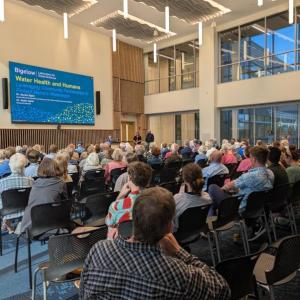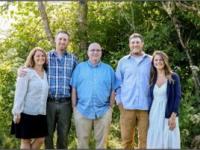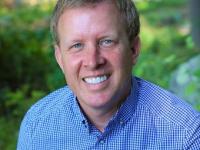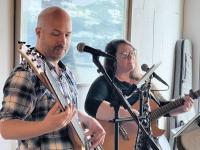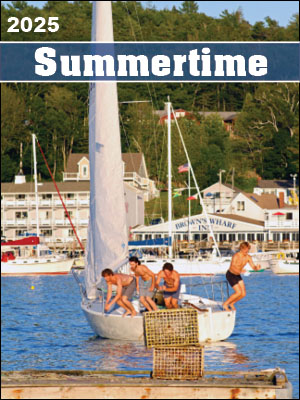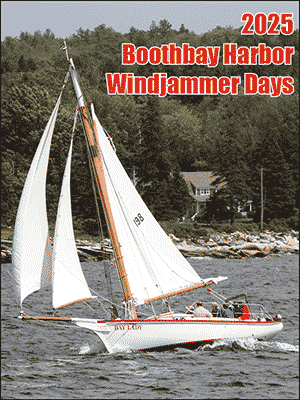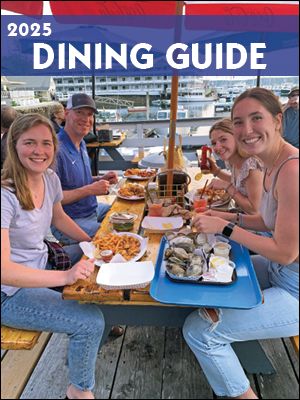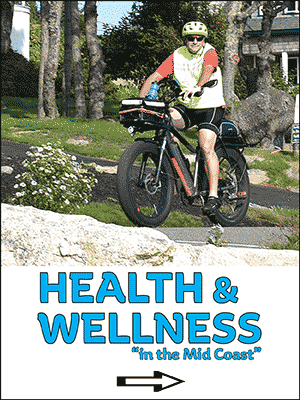Bigelow, communities work together to protect Maine waterways
 Bigelow presents Water Health and Humans Initiative: Leveraging Community Partnerships to Protect Maine’s Waterways. CANDI JONETH/Boothbay Register
Bigelow presents Water Health and Humans Initiative: Leveraging Community Partnerships to Protect Maine’s Waterways. CANDI JONETH/Boothbay Register
 President and CEO Deborah Bronk, left, introduces researchers Dr. Rachel Sipler and Dr. Robin Sleith. CANDI JONETH/Boothbay Register
President and CEO Deborah Bronk, left, introduces researchers Dr. Rachel Sipler and Dr. Robin Sleith. CANDI JONETH/Boothbay Register
 Sipler connects love of Maine to passion for healthy waterways. CANDI JONETH/Boothbay Register
Sipler connects love of Maine to passion for healthy waterways. CANDI JONETH/Boothbay Register
 CANDI JONETH/Boothbay Register
CANDI JONETH/Boothbay Register
 Sleith discusses the benefits of eDNA cataloging for managing the future health of Maine's water bodies. CANDI JONETH/Boothbay Register
Sleith discusses the benefits of eDNA cataloging for managing the future health of Maine's water bodies. CANDI JONETH/Boothbay Register
 CANDI JONETH/Boothbay Register
CANDI JONETH/Boothbay Register
 Bigelow presents Water Health and Humans Initiative: Leveraging Community Partnerships to Protect Maine’s Waterways. CANDI JONETH/Boothbay Register
Bigelow presents Water Health and Humans Initiative: Leveraging Community Partnerships to Protect Maine’s Waterways. CANDI JONETH/Boothbay Register
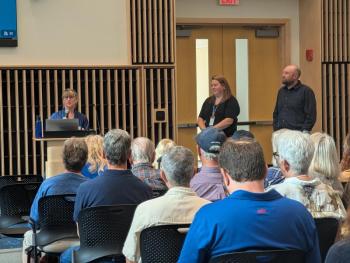 President and CEO Deborah Bronk, left, introduces researchers Dr. Rachel Sipler and Dr. Robin Sleith. CANDI JONETH/Boothbay Register
President and CEO Deborah Bronk, left, introduces researchers Dr. Rachel Sipler and Dr. Robin Sleith. CANDI JONETH/Boothbay Register
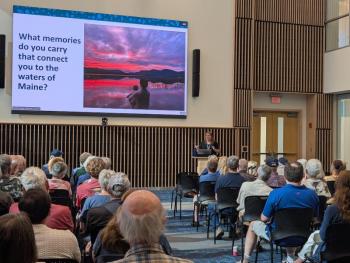 Sipler connects love of Maine to passion for healthy waterways. CANDI JONETH/Boothbay Register
Sipler connects love of Maine to passion for healthy waterways. CANDI JONETH/Boothbay Register
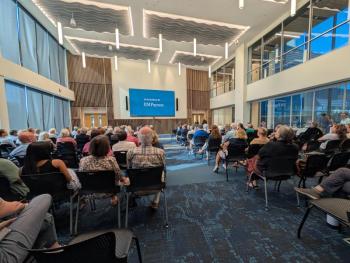 CANDI JONETH/Boothbay Register
CANDI JONETH/Boothbay Register
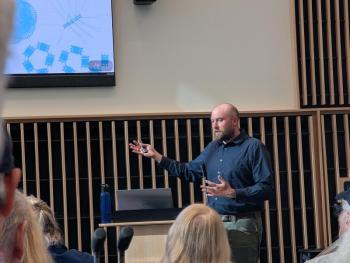 Sleith discusses the benefits of eDNA cataloging for managing the future health of Maine's water bodies. CANDI JONETH/Boothbay Register
Sleith discusses the benefits of eDNA cataloging for managing the future health of Maine's water bodies. CANDI JONETH/Boothbay Register
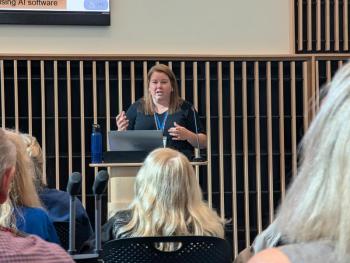 CANDI JONETH/Boothbay Register
CANDI JONETH/Boothbay Register
Bigelow Laboratory for Ocean Sciences (BLOS) hosted the second science talk of its 2025 Café Sci series July 23 on the East Boothbay campus. Partitions between the forum and two classrooms were removed to provide more seating for the popular talks, sponsored by HM Payson. BLOS President, CEO and senior research scientist Deborah Bronk introduced the Water Health and Humans Initiative: Leveraging Community Partnerships to Protect Maine’s Waterways (video) highlighting the interdisciplinary, place-based approach of scientists Dr. Robin Sleith, a plant scientist, and Dr. Rachel Sipler, an expert in water quality.
Sipler, a senior research scientist, emphasized the importance of healthy waterways to Maine's quality of life. The initiative aims to address water and human health challenges through community partnerships, fostering sustainable and collaborative solutions that consider social, environmental and economic factors. “We want to provide science with and for our communities and put science into action and into the hands of the people who need it and use it most,” she said.
According to Sipler, key pressures impacting Maine's waterways include: 1. warming, the Gulf of Maine is warming at an alarming rate, 99% faster than the global ocean. So Maine's coastlines are experiencing warmth faster than the rest of the state. 2. storm severity, 3. changing land use, pollutants and runoff including nutrient excess from agricultural applications, fertilization of home gardens, petroleum residues from roadways, improperly functioning septic systems, and other sources. 4. harmful algal blooms (HABs), resulting from the excess nutrients running off into water bodies. HABs are concentrations of algae or cyanobacteria that negatively impact human or environmental health, causing beach closures, adverse health conditions and the death of shellfish, fish, marine mammals and seabirds. “Some blooms are so destructive they can kill up to 100 tons of fish per day,” Sipler said. “And globally, HABs are incredibly expensive, costing an estimated $1.2 billion annually, with a quarter of that cost attributed to treating drinking water.”
Sleith’s bio reads, “My focus is on harmful algal blooms in coastal ecosystems, which impact recreation, aquaculture, and more. Using a combination of eDNA tools such as metabarcoding and quantitative PCR, we are testing ecological hypotheses around the boom and bust dynamics underlying these blooms in marine and freshwater ecosystems. Ultimately, we want to understand the factors that promote or impede formation of harmful algal blooms to better forecast and manage these events.” His shared research during the talk underscored the value of eDNA sequencing; collecting and filtering organisms, archiving organisms’ DNA for future science, assessing their toxic potential through genetic analysis, quantification of the organisms in a set ecosystem, microbial source tracking (the ability to determine if the pollution is human-caused or linked to animal waste and/or other agents and DNA barcoding, meaning researchers can identify and quantify relative abundance of organisms).
Further, Sleith is a community connector, demonstrating the natural synergy between scientists and community partners. He has worked with several local land trusts and conservation organizations, the Environmental Protection Agency, Damariscotta Lake Watershed Association, students, and volunteers, translating science into stewardship. “Organizations like Midcoast Conservancy actively educate the public about the findings through events and outreach, and their Youth Observation Corps undertakes practical actions like managing runoff to prevent it from entering the lake directly,” he said. This deep involvement allows community members to have ownership of the scientific findings, ask questions, and even help drive some of the research.
The talk reiterates a core theme for Café Sci 2025, that BLOS science happens around the world, and supporters come from around the world, but BLOS wants to emphasize the science and management challenges facing Maine.
“The fact that scientists are working directly with water districts and other groups to be able to give you that (water quality) information is really impactful,” said Sipler. One restoration project she described involves the removal of dams. This effort is a collaboration with the Passamaquoddy Tribe’s Sipayik Environmental Department. Researchers monitor the return and health of fish species in these restored rivers, which provides “crucial information that helps in investing in and prioritizing future restoration efforts to achieve the greatest possible impact as early as possible.”
The talk concluded with an invitation to get involved in understanding the waterways that feed our communities and the management systems that keep Maine’s water, and subsequently Maine’s people, healthy.
July 30, BLOS tackles PFAS (forever chemicals) in Casco Bay, and Aug. 6, the series will conclude with Ocean Epidemiology: Tracking Marine Disease to Protect Fisheries and Ocean Health. The talks begin at 5 p.m., preregistration is required.

